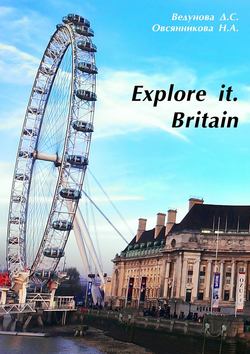Читать книгу Explore it. Britain - Д. С. Ведунова - Страница 6
Northern ireland
ОглавлениеNorthern Ireland, a part of the United Kingdom of Great Britain and Northern Ireland. It is located in the northeast of Ireland. Sometimes the name “Ulster” is used, as Northern Ireland occupies most of the territory of this historic province. It includes six counties: Antrim, Armagh, Down, Fermanagh, Londonderry (Derry) and Tyrone, and 26 districts. The hills surround the central plain. There is the lake Lough Neagh, the largest in the British Isles. The coastline is characterized by pronounced fragmentation and extends from the Gulf of Lough Foyle to the Mourne Mountains. The coastal landscape is very picturesque. The climate of Northern Ireland is temperate with mild winters and cool summers. Rainfall is quite large, and falls more than in the east to the west of precipitation.
Although Northern Ireland has an area of 14,138 km2 or 1/6 of the entire area of Ireland there lives a third of the population of the island. The highest level of industrial development is also a feature of Northern Ireland. The capital city of Belfast is the main industrial center. Northern Ireland has traditionally been the agricultural province, but at the moment in terms of income and number of employees industry is ahead of agriculture.
Northern Ireland has a population of 1570000 people. Approximately half of them live in cities. The largest city is Belfast (281000). It is followed by Londonderry, or Derry (68000). There are also high birth rate and lifespan.
Religion and language. Approximately 3/5 of the population of Northern Ireland are Protestants and more than 2/5 are Catholics. The latter form the majority of population in the town of Londonderry and the counties of Fermanagh and Tyrone.
Most Protestants favor the continuation of the union of Northern Ireland with the United Kingdom, while Catholics prefer to unite with the Irish Republic.
The modern population still reflects the effects of the settlement of Ireland by the English and the Scots in the 17th century. This campaign was conducted under the British colonization policy. The land was alienated from Irish landowners and passed to the English and Scottish settlers. The inhabitants of the eastern regions of Northern Ireland show a great similarity in language and customs with the inhabitants of Scottish plains, while in the south and west some signs of the English origin can be traced
The official language of Northern Ireland is English, although some Catholic schools teach Gaelic.
Education and the arts. Primary and secondary education compulsory for all children aged 5 to 16 years in Northern Ireland. One must pass some exams to enter technical schools. The higher education system includes technical colleges, universities and teacher training colleges. Queen’s University of Belfast, founded in 1845, is known for its medical school and as a center for the study of humanities and technical sciences. University of Ulster in Coleraine was created in 1984 through the merger of the New University of Ulster and the Ulster Polytechnic Institute.
Arts Council of Northern Ireland which is subsidized by the state is engaged in mass propaganda of art. It is responsible for the Fine Arts Center Gallery in Belfast and Londonderry. Ulster Museum in Belfast has an art gallery with an extensive collection of works by Irish artists, European masters of 17—18th centuries and early British watercolors. There is also a rich collection of Irish coins, silver and glassware. A remarkable cultural heritage of Northern Ireland is also displayed at the national Museum in Ulster Kultre near Belfast.
Government and Politics. Since 1920 Northern Ireland was governed in accordance with the Act on the Government of Ireland. The Act provides a substantial degree of autonomy for the Parliament of Northern Ireland. The meetings of the Parliament of Northern Ireland are held in Stormont. The Parliament consists of the Senate, the House of Commons and the Governor is the representative of the British monarch. In 1972, however, the British government appointed a break in the work of the Northern Ireland Parliament. The legislative power was transferred to the British Parliament, and the executive was transferred to the Minister of State for Northern Ireland.
According to the Constitution Bill of Northern Ireland in 1973, the country system of government has been reorganized. The system of proportional representation provided a fair number of places to the Catholic minority. The Assembly had limited rights. Issues related to foreign policy, military, elections and benefits, certain taxes were left for Parliament.
Economy. Northern Ireland is the poorest part of the United Kingdom. Its economy is traditionally focused on agriculture. In most areas, with the exception of County Fermanagh and Tyrone western part of the county where the land is used mainly for grazing, mixed farming is common and farmers are engaged in the cultivation of both crops and raising livestock. Gradually, however, the number of farms is reduced. Large farms equipped with modern appliances appear instead of them. The main agricultural products here are milk, meat, bacon, eggs, oats, potatoes and barley. In Northern Ireland, the mining industry is not developed and it has to import energy resources from the UK. Lignite, iron ore, bauxite, lead, and copper ores can be found in the area of Northern Ireland, but it’s not profitable to extract them. This advanced development of limestone, sand, gravel. Industry is concentrated in the areas of major ports. One of the most famous ports in the entire United Kingdom is Belfast. Among the other major ports there are Larne and Londonderry Industries have been concentrated in the eastern part of the country since the 19th century. The most important are branches of the textile industry and shipbuilding. In the postwar period there was the replacement of old industries and new industries such as space and electronic.
Questions on the basis of the material studied:
1. What is the total area of Northern Ireland?
2. Name the largest city of Northern Ireland.
